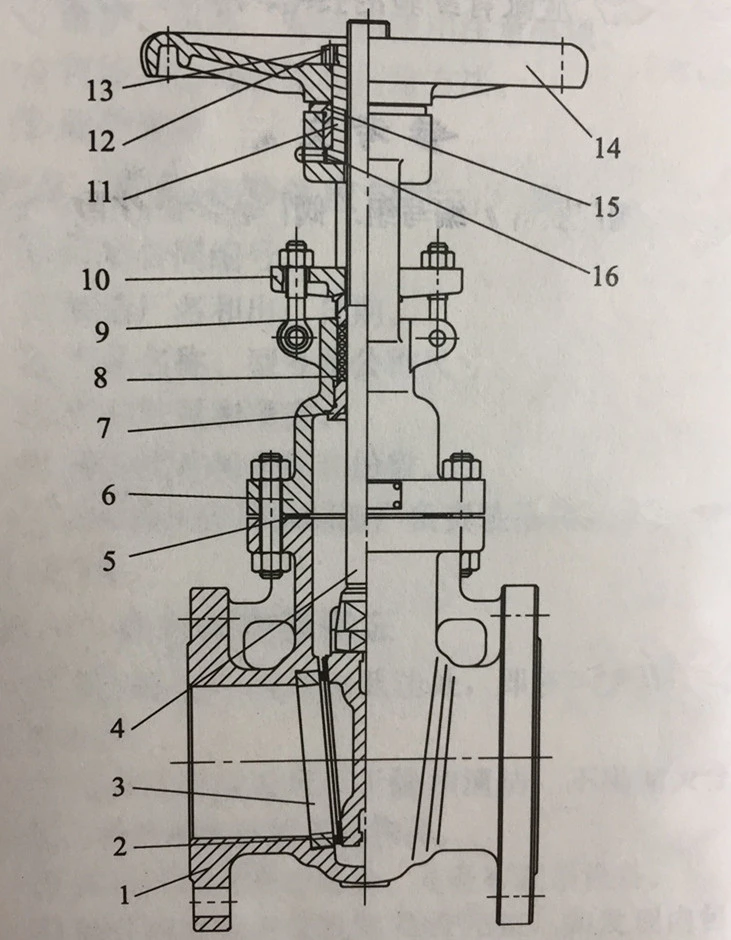Working principles and characteristics of gate valves
A gate valve is also known as a sluice valve, and it is mainly composed of a valve body, a valve bonnet, a gate disc, a valve stem, a valve seat and a packing material.
The structure of a gate valve

1-The valve body; 2-The valve disc; 3-The valve seat; 4-The valve stem; 5-The gasket; 6-The bonnet; 7-The upper seal seat; 8-The packing material; 9-The pack bushing; 10-The packing press plate; 11-The stem nut; 12-The locking nut; 13-The set screw; 14-The hand wheel; 15-The bearing gland; 16-The grease cup
A gate valve is a valve whose dis is driven by the valve stem to have a linear movement along the valve seat (sealing surfaces). In general, a gate valve cannot be used for regulating the flow and can only be used as a cut-off device. It is either fully opened or closed. A gate valve is the most widely used valve among various types of valves. A gate valve can be applied to conditions such as normal temperature and pressure, high temperature, low temperature, high pressure and low pressure. A gate valve can be made of different materials so as to carry various media.
A gate valve has the following advantages.
A gate valve is also known as a sluice valve, and it is mainly composed of a valve body, a valve bonnet, a gate disc, a valve stem, a valve seat and a packing material.
The structure of a gate valve

1-The valve body; 2-The valve disc; 3-The valve seat; 4-The valve stem; 5-The gasket; 6-The bonnet; 7-The upper seal seat; 8-The packing material; 9-The pack bushing; 10-The packing press plate; 11-The stem nut; 12-The locking nut; 13-The set screw; 14-The hand wheel; 15-The bearing gland; 16-The grease cup
A gate valve is a valve whose dis is driven by the valve stem to have a linear movement along the valve seat (sealing surfaces). In general, a gate valve cannot be used for regulating the flow and can only be used as a cut-off device. It is either fully opened or closed. A gate valve is the most widely used valve among various types of valves. A gate valve can be applied to conditions such as normal temperature and pressure, high temperature, low temperature, high pressure and low pressure. A gate valve can be made of different materials so as to carry various media.
A gate valve has the following advantages.
- The fluid resistance is small. The internal media channel of the valve body is straight, and the medium does not change its flow direction when flowing through the gate valve, resulting in small fluid resistance.
- The length of the structure (the distance between the two end surfaces connected to the pipe) is small. The valve plate of the gate valve is discoid and is placed in the valve body. The valve clack of the globe valve which is also discoid is parallelly placed in the valve body. Compared with the globe valve, the length of the structure of the gate valve is smaller. For example, a globe valve with pressure PN16 and size DN150 has a structure length of 480mm, while a gate valve with the same parameter only has a structure length of 350mm.
- The gate valve is easy to be opened and closed. When the gate valve is opened or closed, the direction of movement of the valve plate is perpendicular to the direction of the flow of the medium. The movement direction of the valve clack of the globe valve is usually opposite to that of the medium at the valve seat when the glove valve is closed. Therefore, the acting force of the medium must be overcome. Compared with the glove valve, the gate valve is easy to be opened and closed.
- The direction of media flow is not limited. The medium can flow through the gate valve in any direction from both sides of the gate valve and achieve the aim of the medium flowing or being intercepted in the pipeline. It is easy to install a gate valve, and a gate valve is applied to pipelines where the flow direction of the medium may change.
- When a gate valve is fully opened, the sealing surface is hardly affected by the working medium.
The body structure of a gate valve is relatively simple and the manufacturing process of a gate valve is better.
